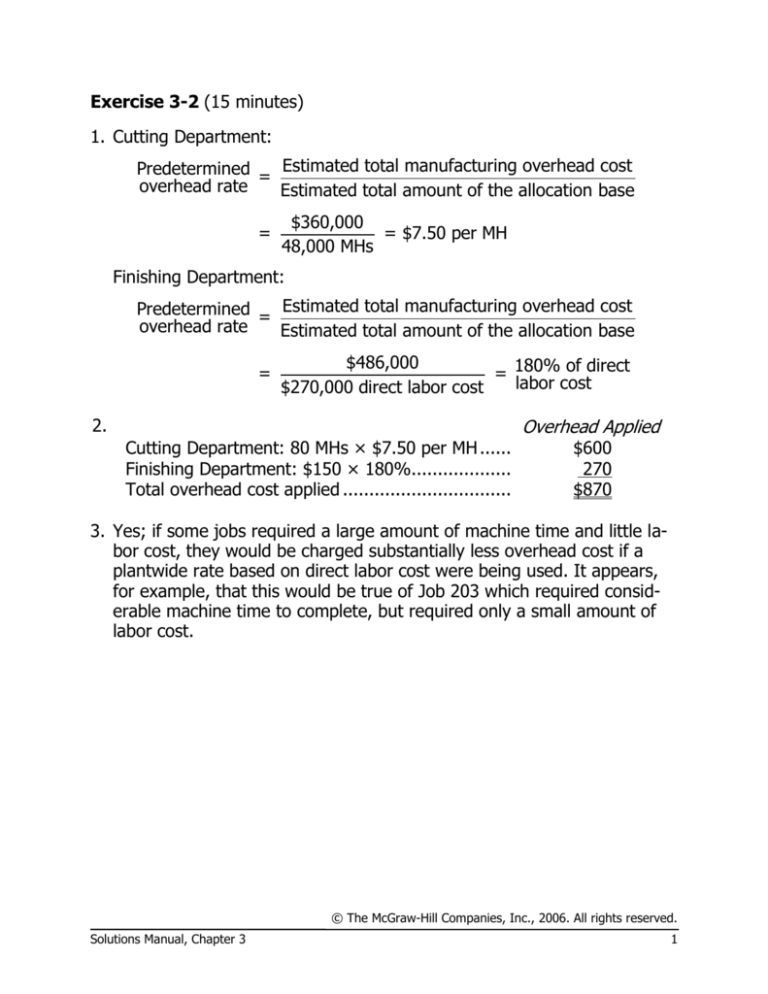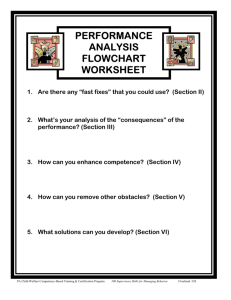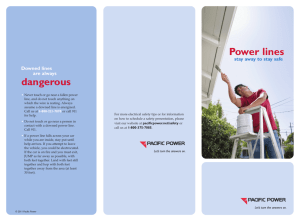
Exercise 3-2 (15 minutes)
1. Cutting Department:
Predetermined = Estimated total manufacturing overhead cost
overhead rate
Estimated total amount of the allocation base
=
$360,000
= $7.50 per MH
48,000 MHs
Finishing Department:
Predetermined = Estimated total manufacturing overhead cost
overhead rate
Estimated total amount of the allocation base
=
$486,000
= 180% of direct
labor cost
$270,000 direct labor cost
2.
Cutting Department: 80 MHs × $7.50 per MH ......
Finishing Department: $150 × 180%...................
Total overhead cost applied ................................
Overhead Applied
$600
270
$870
3. Yes; if some jobs required a large amount of machine time and little labor cost, they would be charged substantially less overhead cost if a
plantwide rate based on direct labor cost were being used. It appears,
for example, that this would be true of Job 203 which required considerable machine time to complete, but required only a small amount of
labor cost.
© The McGraw-Hill Companies, Inc., 2006. All rights reserved.
Solutions Manual, Chapter 3
1
Exercise 3-4 (30 minutes)
1. Since $120,000 of studio overhead was applied to Work in Process on
the basis of $75,000 of direct staff costs, the apparent predetermined
overhead rate is 160%:
Studio overhead applied
$120,000
=
= 160% rate.
Direct staff costs incurred
$75,000
2. The Lexington Gardens Project is the only job remaining in Work in Process at the end of the month; therefore, the entire $35,000 balance in
the Work in Process account at that point must apply to it. Recognizing
that the predetermined overhead rate is 160% of direct staff costs, the
following computation can be made:
Total cost in the Lexington Gardens Project .......
$35,000
Less: Direct staff costs ..............................................
$ 6,500
Studio overhead cost ($6,500 × 160%).............
10,400 16,900
Costs of subcontracted work .............................
$18,100
With this information, we can now complete the job cost sheet for the
Lexington Gardens Project:
Costs of subcontracted work ........
Direct staff costs .........................
Studio overhead ..........................
Total cost to January 31 ..............
$18,100
6,500
10,400
$35,000
© The McGraw-Hill Companies, Inc., 2006. All rights reserved.
2
Managerial Accounting, 11th Edition
Exercise 3-6 (30 minutes)
Note to the instructor: This exercise is a good vehicle for introducing the
concept of predetermined overhead rates. This exercise can also be used
as a launching pad for a discussion of the appendix to the chapter.
1. Since manufacturing overhead is mostly fixed, the cost per unit increases as the level of production decreases. This apparent problem can be
“solved” using predetermined overhead rates, which should be based on
expected activity for the entire year. Many students will use units of
product in computing the predetermined overhead rate, as follows:
Predetermined = Estimated total manufacturing overhead cost
overhead rate
Estimated total amount of the allocation base
=
$960,000
= $4.80 per unit.
200,000 units
The predetermined overhead rate could also be set on the basis of either direct labor cost or direct materials cost. The computations are:
Predetermined = Estimated total manufacturing overhead cost
overhead rate
Estimated total amount of the allocation base
=
$960,000
= 300% of direct
labor cost.
$320,000 direct labor cost
Predetermined = Estimated total manufacturing overhead cost
overhead rate
Estimated total amount of the allocation base
=
$960,000
= 160% of direct
materials cost.
$600,000 direct materials cost
© The McGraw-Hill Companies, Inc., 2006. All rights reserved.
Solutions Manual, Chapter 3
3
Exercise 3-6 (continued)
2. Using a predetermined overhead rate, the unit product costs would be:
First
Quarter
Second
Third
Fourth
Direct materials ................... $240,000 $120,000 $ 60,000 $180,000
Direct labor ......................... 128,000
64,000
32,000
96,000
Manufacturing overhead:
Applied at $4.80 per unit,
300% of direct labor
cost, or 160% of direct
materials cost ................... 384,000 192,000
96,000 288,000
Total cost ........................... $752,000 $376,000 $188,000 $564,000
Number of units produced ...
80,000
40,000
20,000
60,000
Unit product cost .................
$9.40
$9.40
$9.40
$9.40
© The McGraw-Hill Companies, Inc., 2006. All rights reserved.
4
Managerial Accounting, 11th Edition
Exercise 3-13 (30 minutes)
1.
Predetermined = Estimated total manufacturing overhead cost
overhead rate
Estimated total amount of the allocation base
=
$192,000
= $2.40 per MH
80,000 MHs
2. The amount of overhead cost applied to Work in Process for the year
would be: 75,000 machine-hours × $2.40 per machine-hour =
$180,000. This amount is shown in entry (a) below:
(Maintenance)
(Indirect materials)
(Indirect labor)
(Utilities)
(Insurance)
(Depreciation)
Balance
(Direct materials)
(Direct labor)
(Overhead)
(a)
Manufacturing
Overhead
21,000
180,000
8,000
60,000
32,000
7,000
56,000
4,000
(a)
Work in Process
710,000
90,000
180,000
3. Overhead is underapplied by $4,000 for the year, as shown in the Manufacturing Overhead account above. The entry to close out this balance
to Cost of Goods Sold would be:
Cost of Goods Sold ......................................
Manufacturing Overhead .........................
4,000
4,000
© The McGraw-Hill Companies, Inc., 2006. All rights reserved.
Solutions Manual, Chapter 3
5
Exercise 3-13 (continued)
4. When overhead is applied using a predetermined rate based on machine-hours, it is assumed that overhead cost is proportional to machine-hours. So when the actual machine-hours turn out to be 75,000,
the costing system assumes that the overhead will be 75,000 machinehours × $2.40 per machine-hour, or $180,000. This is a drop of $12,000
from the initial estimated manufacturing overhead cost of $192,000.
However, the actual manufacturing overhead did not drop by this much.
The actual manufacturing overhead was $184,000—a drop of $8,000
from the estimate. The manufacturing overhead did not decline by the
full $12,000 because of the existence of fixed costs and/or because
overhead spending was not under control. These issues will be covered
in more detail in later chapters.
© The McGraw-Hill Companies, Inc., 2006. All rights reserved.
6
Managerial Accounting, 11th Edition





